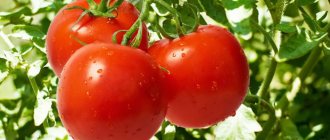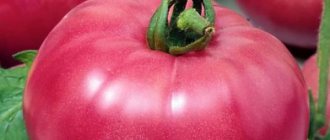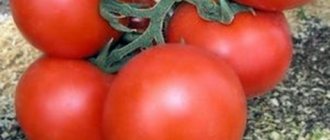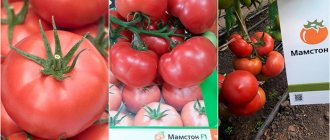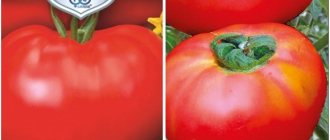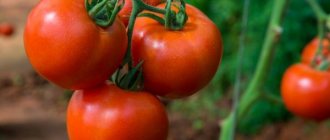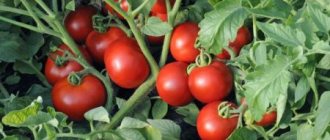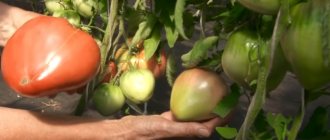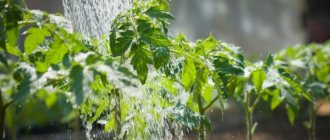Characteristics of tomato variety Lokomotiv and description of fruits
One of the suitable varieties for cultivation in open ground is the Lokomotiv tomato. This is a standard version, and if grown correctly, you can get a very good harvest.
- 1 Description of the variety
- 2 Characteristics of fruits
Breeders are constantly improving tomato varieties. Among all the variety that is presented on the Russian market, you can find different types of tomatoes. Some of them are distinguished by excellent productivity, others tolerate cold, and there are also universal tomatoes that can be successfully grown in open ground and at the same time obtain a large number of delicious fruits.
Experts believe that those tomatoes whose fruits ripen quickly enough are best suited for soil cultivation. This way the tomatoes have time to ripen even in cool summers, but most importantly, they get sick less, since diseases mainly affect late-ripening tomatoes that hang on the bushes for a long time.
Description of the variety
The Lokomotiv variety is valued by many summer residents and gardeners because it not only produces early fruits, but is also absolutely unpretentious in care, as evidenced by numerous reviews. These are small bushes that do not need to be formed, tied up or pinched. At the same time, productivity remains consistently high.
Lokomotiv is classified as an ultra-early variety. From the moment the seeds are sown for seedlings until the delicious fruits are obtained, only 85 days pass. That is why such tomatoes can be grown even in open beds in those regions where the weather in summer can be quite capricious. If we are talking about planting Lokomotiv in regions with cold summers, you should choose greenhouse cultivation. Experienced summer residents say that the method of maintaining bushes does not affect the yield.
According to the information contained in the characteristics and description of the variety, Lokomotiv belongs to the standard species. This is a determinate plant that grows up to 70 cm maximum.
If the gardener chooses open ground, the bushes will be much smaller in size. Such plants do not need to be tied up, as they have a strong stem. As for stepping and formation, this is not necessary for Lokomotiv. This does not affect the yield at all.
The bushes are not too tall, but quite lush. Therefore, planting them close to each other is not recommended. If you plant 4 plants per 1 m², the tomatoes will have enough nutrients and sun. In this case, the yield will be maximum. With this planting scheme, up to 15 kg of fruit can be collected from 1 m².
Additional advantages include the resistance of this tomato to many diseases. The locomotive does not suffer from common late blight or powdery mildew. All fruits ripen early and smoothly. Therefore, they are very convenient to recycle.
Fruit characteristics
The locomotive has a lot of advantages. This variety is suitable for growing in any area, the tomatoes ripen quickly, the yield is friendly, and the tomato rarely gets sick. But for some gardeners, this is not what plays a decisive role when choosing the right variety. Many people prefer to plant only tomatoes with unusual shapes. And in this case, Lokomotiv will again be one of the favorites.
The fruits of this variety resemble small pears. The tomatoes turn out the same, the weight of 1 fruit is about 120 g. These tomatoes are excellent for summer vitamin salads and for preparations. Pear-shaped tomatoes look great in jars.
The color of the fruits of this variety is red. Tomatoes have red flesh, and inside the tomato there are 4 chambers with a small number of seeds. The flavor of these tomatoes is great for canning. The fruits have a fairly pronounced acidity, so they will be an excellent basis for pickling and pickling for the winter.
Despite the fact that Lokomotiv tomatoes are more often used for preparing salads, these fruits have gained the greatest popularity due to their appearance in jars. Beautiful red “pears” will be an excellent addition to the menu of any holiday table. These tomatoes have thick but thin skin. They do not crack during heat treatment. Also, Lokomotiv fruits are stored for a long time.
Description of the variety
The Lokomotiv variety is an early-ripening vegetable crop. It takes about 85-90 days from the first germination of seeds to full maturity of the fruit. The variety is intended for cultivation in both open and closed beds. At the same time, different growth conditions do not affect its yield and quality of fruits.
By type, the tomato variety Lokomotiv belongs to standard crops. A bush of determinate species, the height of which in rare cases reaches more than 70 cm.
The advantages of the variety include:
- excellent fruit quality;
- early and high yield;
- good transportation;
- long shelf life of fruits;
- ease of care;
- resistance to powdery mildew.
When planting 3-4 bushes per 1 sq. m. a summer resident will be able to collect up to 13 kg. fruits At the same time, the plant ripens tomatoes quickly, which facilitates their rapid processing.
Yield tomato variety “Slot F1”: secrets of cultivation and description of the variety
In the spring, all summer residents rush to their plots; they need to tidy up the overwintered beds and select seedlings. For all lovers of red small-fruited tomatoes there is a very good variety, it is called “Slot F1”.
It will especially appeal to novice summer residents who have not had time to acquire greenhouses; it is recommended to grow them in open ground. It is unpretentious and has good productivity.
In our article you will find a complete description of the variety, get acquainted with its characteristics, cultivation features and see photos.
Show content
Tomato “Slot F1”: variety description
This is a medium-late variety; 115-120 days pass from the moment the seedlings are planted until the first fruits ripen. The plant is standard, determinate, the height of the bush is 100-150 cm. The variety is recommended for cultivation in open ground, but some achieve results under film covers, and even try to grow it on balconies. There are F1 hybrids of the same name. This type of tomato has fairly good resistance to Alternaria.
Fruits that have reached varietal maturity have a bright red color and are rounded and flattened in shape. The average size of the fruit is 60-70 g, later the size of the fruit decreases to 50-55 g. The number of chambers in the fruit is 2-3, the dry matter content is approximately 4%. The collected fruits tolerate long-term storage and transportation well.
The variety “Slot F1” was obtained by Russian specialists and received state registration as a variety for open ground in 1999. Since that time, it has enjoyed deserved popularity among summer residents and owners of small farms.
You can compare the weight of fruits of the Slot variety with others in the table below:
Characteristics
Southern regions such as Crimea, Astrakhan region or Krasnodar region are suitable for successfully growing this type of tomato. In the middle zone, tomatoes are usually grown in film shelters; this does not significantly affect the yield.
Tomatoes of the “Slot F1” variety are excellent fresh. They are very well suited for whole-fruit canning and barrel pickling.
They make very good juice due to their low dry matter content and good balance of acids and sugars. With careful care, you can get from 5 to 7 kg from one bush.
With recommended planting, 4 bushes per square meter. m, it turns out from 20 to 28 kg. This is a pretty good result for such varieties.
You can see the yields of other varieties in the table below:
Among the main advantages of this type of tomatoes are:
- resistance to temperature changes;
- good yield;
- taste qualities of fruits;
- tolerance to lack of moisture.
Among the disadvantages, one can highlight the fact that at the bush growth stage, this type of tomato is capricious in terms of fertilizing.
Features of cultivation
Among the features of this type of tomato, many notice the shape of its fruits and the rather late ripening period.
Also, many people notice that it can be grown in extreme heat, this does not affect the yield. The bushes of this plant form one or two stems, but more often two.
At the growth stage of the bush, it responds very well to fertilizers containing potassium and phosphorus; later, you can switch to complex ones.
Bushes and branches need garters and supports to avoid them breaking off under the weight of fruits, of which there are many on the branches.
Diseases and pests
In the southern regions, the Colorado potato beetle can cause great harm to the plant; it is combated with the help of the drug “Prestige”. In the middle zone, the main pest is the mole cricket; the drug “Gnome” is used against it. “Bison” is most often used against rusty mites.
This is not the most difficult type of tomato to care for, and at the same time it is very productive; even a novice summer resident can cope with cultivation. Good luck and great harvests.
In the table below you will find links to tomato varieties with different ripening periods:
Tomato Prize: characteristics and description of the variety, reviews of tomato yields, photos of the bush
From each tomato bush of this variety you can collect delicious fruits - large and very beautiful, with a pleasant aroma and taste. The surface of the tomatoes is glossy; at the stage of technical maturity they acquire a rich red color. The shape is flat-round and even. The pulp of the fruit is dense and fleshy. The average weight of one tomato is about 300-600 grams.
In reviews of the Superbomb tomato, gardeners say: tomatoes of this variety have a universal purpose. The fruits are good both fresh and processed.
You can use them to prepare salads, tomato paste, purees, and winter canning.
Gardeners from regions with capricious climates note that the variety is quite hardy, even under unfavorable weather conditions it allows you to get an excellent harvest of tasty and aromatic fruits.
Tomato "Lokomotiv": description of the variety
| Variety name | Locomotive |
| general description | Mid-season determinate variety |
| Originator | Russia |
| Ripening period | 80-95 days |
| Form | Elongated |
| Color | Red |
| Average weight of tomatoes | 120-150 grams |
| Application | Universal |
| Productivity of the variety | 12-15 kg per sq.m |
| Features of cultivation | Standard agricultural technology |
| Disease resistance | Prevention is needed |
Tomatoes of this type were developed quite recently by Russian specialists. It received state registration as a separate variety for universal use in 2010. Since then, it has been respected among gardeners and farmers for its yield and commercial qualities.
According to the type of bush, it belongs to standard determinate plants. Equally well suited for growing in film shelters and in open ground.
Among lovers of this species, resistance to the most common diseases is noted.
Tomato variety "Lokomotiv" is a low-growing plant, about 50-60 centimeters, early ripening; from the moment of planting the seedlings, the first fruits should be expected in 80-95 days.
The main recognizable feature of this species is the shape of its fruits; it is elongated. Also among the features noted are high taste qualities. The harvested crop tolerates transportation and storage well.
Details about
diseases of tomatoes in greenhouses
read the articles on our website, as well as
about methods and measures to combat them
.
You will also be able to get acquainted with information about high-yielding and disease-resistant varieties, about tomatoes that are not at all susceptible to late blight.
Advantages and disadvantages of the variety
Pros:
- great taste;
- attractive fruits;
- high productivity;
- ease of care;
- early ripeness and friendly ripening.
Minuses:
- No shortcomings were noted.
Despite the fact that this variety appeared quite recently, farmers have already managed to appreciate its advantages. The main advantage for summer residents is the large fruits, which are distinguished by excellent taste.
The Superbomb tomato (in the photo you can see the location of the fruits on the bush) demonstrates high productivity even under unfavorable climatic conditions, in rainy and cloudy summers.
Speaking about the Superbomb tomato, vegetable growers note that it is one of the most productive among mid-season varieties. In addition, Superbomb is not afraid of most ailments that are characteristic of tomato crops. And the only drawback of the variety, gardeners call its susceptibility to diseases such as late blight and alternaria.
Tomato often suffers from pests, including mole crickets, wireworm caterpillars and whiteflies. True, this problem is easily solved: in order to destroy the whitefly, the drug “Confidor” is suitable.
To combat the mole cricket, you will need a chemical called “Thunder”, a vinegar solution or a tincture of hot pepper.
In order to protect vegetables from wireworms, you need to lime the acidic soil and apply a product such as “Bazudin”.
Recommendations for cultivation
This is a universal variety of tomato; it can be grown in open ground and in greenhouse shelters. The southern regions of Russia, such as the Crimea, the Caucasus or the Krasnodar Territory, are suitable for open ground. For more northern regions, cultivation in greenhouses is recommended.
This hybrid is also grown in the central regions, but there is a certain amount of risk, since its yield may decrease. When growing, this species requires no more care than others, that is, timely feeding, loosening the soil and observing the watering regime. Does not require pinching.
Transplantation to a permanent place
The optimal time for planting seedlings in a permanent place is from early to mid-May in a greenhouse, from late May to early June in open ground.
For tomatoes of this variety, neutral soil mixtures are best suited, preferably well-drained.
Before planting, a small amount of organic fertilizer must be added to each prepared hole. Then the soil must be watered and only after that the tomatoes should be planted.
Plant care
Gardeners note that Superbomb does not require excessive care. It is responsive to moisture and the application of complex mineral and organic fertilizers. Superbomb is sensitive to a lack of boron and potassium in the soil. Plants need to be watered abundantly, but not often. Please note: water should be poured only at the root, being careful not to get on the ovaries or leaves.
This is fraught with the appearance of fungal diseases. Make sure that the air in the greenhouse is not too humid and ventilate it in a timely manner. Watering should be especially abundant during the period of fruit formation. Summer residents say: the best method of moistening the soil is a drip irrigation system, which allows the bushes to develop deep, strong roots.
https://www.youtube.com/watch?v=MmB9HekJBlA
Immediately after planting, as well as after each watering, the soil under the tomato bushes must be mulched. The plant will also need pinching and tying to a support. It is best, say experienced gardeners, to form a bush with three stems.
Characteristics and detailed description of the tomato variety Tatyana
The Tatyana tomato, the characteristics and description of the variety of which is available on the forums, was bred by Russian breeders. This type of tomato is not a hybrid and is an analogue of the Tanya F1 variety, which was bred in Holland as a hybrid of several tomato species.
The Tatyana variety is characterized by cultivation in open ground, although seedlings can be planted in greenhouses, greenhouses, and film shelters. The variety is productive and unpretentious. Tomatoes are often planted by gardeners who do not have greenhouses in their dachas. The method of planting does not affect the yield, since the bushes do not require special care.
Description of tomato
Characteristics and description of the tomato variety Tatyana:
- Early ripening variety.
- High-yielding.
- Determinate plants that reach a maximum height of 60 cm.
- The plants are branched and standard.
- The tomato variety has a strong stem on which a beautiful, abundant green mass is formed. Thanks to this, the tomato resembles ornamental plants in the garden.
- The leaves are simple, medium in size and dark green in color.
- The fruits ripen on the branches in clusters of 3-5 pieces on each cluster.
- The variety can be planted as indoor plants. To do this, you need to purchase flowerpots or pots of appropriate sizes. Containers with tomato bushes are placed on balconies, verandas, and terraces.
- The fruits demonstrate excellent keeping quality and transportability over long distances.
Advantages of the Tatyana variety:
- The fruits ripen quickly and smoothly.
- High yields are noted both from one bush and from the entire plot.
- Excellent fruit taste.
- Bushes of this variety are resistant to diseases.
- Compact dimensions allow you to save space on your summer cottage or balcony.
Summer residents who have already planted Tatyana tomatoes speak highly of the fruits of the variety. The main characteristics of tomato include the following:
- The fruits grow small and are of medium size.
- The weight of each tomato varies from 120 to 200 g, sometimes more - up to 250 g.
- Tomatoes have a round shape that is slightly flattened at the top and bottom. The stalk has slight ribbing.
- Inside the fruit there is juicy and fleshy pulp. There are few seed chambers.
- Tomatoes are covered with thin, glossy skin that does not crack during transportation or ripening.
- The fruit contains a high content of dry substances and sugars, which give tomatoes a sweet, rich, pleasant taste and aroma.
Reviews from those who planted this variety indicate that the juicy fruits can be used to make tomato juice, soups, pastes and purees, and fresh salads. Tomatoes of the Tatyana variety are also eaten fresh. This is an excellent addition to main courses, making any lunch more satisfying and healthy.
Many summer residents use Tatyana fruits for canning as whole fruits. This is facilitated by its small size and dense skin, which does not crack during heat treatment.
How to grow tomatoes
To plant in summer cottages, it is necessary to first grow seedlings. To do this, you need to buy seeds and prepare boxes with soil. Before planting, the seeds are treated with a growth stimulant and then planted in the ground. Soil from the garden is suitable, which is recommended to be mixed with humus and river sand.
Sowing seeds for seedlings is carried out in early March; the seeds should be deepened into the soil no more than 2 cm. Sprinkled with peat, the ground is sprayed with water from a spray bottle, then the boxes are covered with film and placed in a room with a stable temperature. It should not fall below +25ºС. This allows the seeds to germinate faster.
As soon as the seedlings emerge from the ground, the boxes are moved to the windowsill in natural light. If this is not possible, then you need to place fluorescent lamps near the drawers. “Tanya” sprouts are watered once every few days, when the top layer of soil becomes dry. Watering should be moderate and done from a watering can or spray bottle.
Picking is carried out when the first leaves on the plant are formed. Additionally, the bushes are fed with complex fertilizer, which is diluted with water according to the instructions.
In the second half of May, the seedlings are transferred to the soil, which by this time is already warming up. Bushes are transferred to film and greenhouse shelters earlier.
Before planting, you need to add humus to the ground and loosen it. The bushes are planted at a distance of 30 to 40 cm. During the growing season, the lower leaves must be removed, which accelerates the flow of air to the roots. There is no need to tie or pin. During the season, the bushes should be fed with organic and mineral fertilizers.
Advantages and disadvantages
The positive characteristics endowed with the Rugantino tomato have made the hybrid a desirable “settler” in the areas of lovers of unusual vegetables.
Advantages of the variety:
- The tomato was bred for the purpose of growing in greenhouses of various designs. However, in the southern regions the hybrid grows well in the garden, in an open bed. How to plant a crop correctly, read this article.
- The tomato adapts perfectly to various growing conditions. The ovary is formed even in extreme heat, when the pollen of other varieties is sterilized.
- High yield and extended fruiting.
- The fruits are attractive in appearance.
- The inside of the tomato is fleshy. The taste combines sweetness with a slight amount of acid.
”alt=””>
The main disadvantage is that the variety requires constant shaping. Otherwise, they get a lot of green mass to the detriment of fruiting.
Among the undeniable advantages of early Sanka tomatoes are the following:
- low growth of the crop does not require tying the bushes to the supports. However, if the area with plants is located in an open, windy area, it is advisable to strengthen such tomatoes;
- the Sanka variety is early ripening, making it one of the first to enjoy fresh fruits;
- long fruiting period, especially when grown in a greenhouse;
- has proven itself well in conditions of open ground breeding; it does not need to be sown;
- tomatoes can be grown quite closely to each other due to the small size of the bushes;
- Due to the fact that the variety is not a hybrid, you can use the seeds of your own grown fruits for subsequent plantings.
The main disadvantage of Sanka tomatoes is that the variety is often susceptible to late blight. However, if preventative measures are taken, this can be avoided.
What is the difference between hybrids and other tomato varieties?
Today, for every thousand varieties of tomatoes, there are about eight hundred hybrids. A variety is usually represented as one or a group of plants, with the sole condition that these plants can be used for reproduction. Hybrids are a crossing between selected parent plants, during which a new type of hybrid plant is obtained. Regular tomato varieties may not be as productive as hybrids, but they have excellent taste and can also be used to produce seeds and further produce tomatoes of this variety.
Many farmers support the method of hereditary cultivation of tomatoes on their plot, that is, they plant only those seeds that have proven themselves to be the best, and from generation to generation, have given a good harvest and are highly productive. Such varieties can be safely called family heirlooms among tomato varieties.
Hybrids, on the other hand, are tomatoes whose breeding was obtained under control, in the process of long and complex breeding work. Hybrids can be called the same tomato varieties, only with improved qualities, for example, increased resistance to disease or a high yield threshold. In fact, if you approach the process of growing tomatoes on a production scale, then hybrids will greatly benefit from conventional varieties. They will produce good yields, rapid ripening, increased shelf life and shelf life, as well as high quality fruit. However, hybrids have one significant drawback. Hybrid varieties are deprived of the ability to reproduce.
If you want to plant hybrid seeds obtained from the original source, then most likely something similar to a tomato will grow, since in the second generation of plant hybrids there is a complete loss of its hybrid qualities. Also, care for tomato hybrids must be appropriate, since the plant will reveal its hybrid qualities only when appropriate care is organized for it. So if you do not have tomato varieties that differ in any qualities that attract you, but want to get a high yield of tomatoes, then the solution would be to cultivate hybrids on your plot. When purchasing hybrid seeds, carefully study the packaging, which will indicate what hybrid qualities the future plant will have.
Description of tomato Slivovka
There are many different types of tomatoes, each of them differs from each other in its characteristics and qualities and, most importantly, in yield. The Slivovka tomato is a relatively new and interesting species that was created using hybridity.
Description of tomato Slivovka
Description of the variety
Tomatoes of this type grow short, about 40-45 cm. They are classified as determinate varieties of tomatoes. The structure of the fruits is round and slightly oblong, somewhat reminiscent of small zucchini. They are also often compared to plums because of their shape, which is where the name Slivovka comes from. The fruits are always just red, rich and ruddy. The total weight of one fruit is usually from 75 grams. and up to 110 gr. The very first fruits will be the largest, and then, when the bush grows, there will be more fruits, but their mass will change slightly.
Tomatoes demonstrate good productivity, up to 10 kg are obtained from 1 bush. The variety is considered universal, so the fruits are also used for fresh use, and are also suitable for canning, tomato, and dressing. Often one bush is 2-3 stems, but most often only 2 are used. It can be planted in open ground; the soil is not important for this variety.
Positive aspects of the variety
Absolutely any plant has its positive and negative sides. Rarely are negative aspects noticed in this species. And, if you believe the reviews of many gardeners, there are none at all.
The positive aspects are presented below.
- The fruits are distinguished by their versatility, ripen well and grow to medium sizes. They have a pleasant and rich taste. Some say that it has a sweet taste with sourness, while others say that the variety is generally sweet.
- Interesting and attractive external characteristics, beautiful appearance, which gives a big plus to the Slivovka variety.
- A significant advantage is that this variety has good yield results.
- Due to the fact that the variety was bred artificially, it has excellent resistance to diseases and pests, they rarely get sick, so you will not have problems with this. The bushes are durable, the main thing is to take care of them.
- The fruits ripen very quickly and by their color (red) it becomes clear that they are ripe.
- Varietal qualities are excellent.
The fruits of this variety can withstand long-term storage
The positive aspects include the fact that a tomato of this type can be stored for a very long time, the main thing is to withstand all storage standards. They should be placed in wooden boxes, preferably with newspaper between each layer, and of course, moisture and temperature must be taken into account. According to reviews from gardeners, it is clear that this variety can last until the New Year.
Negative points
The description of the variety demonstrates that tomatoes also have some disadvantages. Sometimes there are situations when the seedling does not grow. This happens very rarely, and most often due to the fact that he is simply “capricious.” Perhaps he did not like the very fact that he was transported and planted from one conditions and soils to others. In this case, the bush will either simply grow poorly at first, or die completely. It is then that it is necessary to intensively provide fertilizer and humus, add calcium and watering.
Despite this disadvantage, such situations are rare. The tomato root system has good resistance. They can withstand severe frosts and severe drought, but then it is unlikely that good yields can be expected from them.
Rules for planting varieties
Most experts advise carrying out the sowing stage 30-33 days before the first warm weather. That is, it is best to do this in early spring, but when there is no longer frost. You can plant 3-4 pieces per m². seeds, but no more. This can lead to the roots growing incorrectly and, as a result, not taking the necessary vitamins from the soil and then you will not get a good harvest.
And of course, the most important rule is to fertilize the soil before planting the plant. First, the area needs to be dug up, and then only fertilized. Basically, as mentioned earlier, the plant can live and flourish in any soil.
Growing and Harvesting
Often, tomatoes are planted at the beginning of March and the end of April. On one plant they leave 2 stems, sometimes 3, but this phenomenon is very rare. The bush also needs to be tied up when it reaches its peak of ripening; the fruits will gain mass and break the branches.
Fruit characteristics
A distinctive feature of the variety is the original shape of the fruit. In appearance they resemble small pears. For such an original shape and taste, Lokomotiv tomatoes have received universal recognition among summer residents.
Distinctive characteristics of Lokomotiv tomatoes:
- weight – 130-150 grams;
- color – bright red;
- pulp – dense, with 4 chambers;
- the taste is spicy, with a slight sourness.
A variety for universal use. Its tomatoes can be consumed fresh, in the preparation of summer salads, winter preparations, tomato sauces and pastes.
It is worth paying attention: the vegetable crop has gained particular popularity in whole-fruit canning. Thin but durable skin does not crack during heat treatment, which allows you to surprise guests with whole tomatoes in winter
Description of the standard tomato variety Lokomotiv and its characteristics
Using the trial method, breeders from different countries came to a consensus that early, standard varieties are better suited for growing tomatoes in open ground. Such compact tomatoes do not require the formation of a bush and further pinching of the shoot. This is the case with the Lokomotiv vegetable crop, which was bred not so long ago by Russian breeders. Having passed all the tests, the variety received state registration in 2010. Since that time, the Lokomotiv tomato has been cultivated in different regions of the country, where it is gaining increasing popularity every year for its excellent fruiting qualities.
Reviews about the variety from those who planted
Tomato criteria
Every gardener dreams of surprising his neighbors and household members with the resulting harvest of excellent quality tomatoes. To fulfill this dream, it is enough to plant a relatively young tomato variety “Lokomotiv” on your personal plot, the characteristic features of which are described in this article.
When following the recommended planting density (no more than 4 seedlings), 1 m2 of plantings can yield a harvest of 12 to 15 kg.
The tomato variety “Lokomotiv” is universal, suitable for growing in unprotected soil and greenhouse structures. It is advisable to grow in open ground in the southern regions of Russia, for example, in the Crimea or Krasnodar Territory. In more northern regions, the Lokomotiv tomato is grown in greenhouses. The central regions are also suitable for growing the variety, but with a certain degree of risk, since a reduction in the amount of harvest is possible.
Thanks to its yield and commercial qualities, the Lokomotiv tomato variety enjoys well-deserved love among vegetable growers and farmers. During its existence, the tomato has proven itself exclusively on the positive side. The variety has captivated gardeners with its unpretentiousness.
The Lokomotiv tomato variety has virtually no disadvantages. The tomato has many differences compared to other tomato crops. "Lokomotiv" can be grown in various climatic zones. The variety is characterized by high yield and excellent quality fruits.
Tomato criteria
Bush formation
Thanks to the root system, which is located close to the surface, the bush of this type of tomato is formed quickly, and you will need the following actions:
- removal of the lower leaves and stepsons throughout the entire growing season (as a result, the bush will produce about 7-8 almost simultaneously ripened brushes);
- the leaves in the lower part of the bush begin to be removed when the plant reaches a height of about 20 cm - but you should not get carried away;
- It is recommended to monitor the crown as follows: select the central, thickest and most durable stem, and pinch off all the stepsons, flower ovaries and small fruits outside it;
- in addition, it is better to remove the lower leaves under those fruits whose ripening has entered the final stage;
- pinching (taking into account planting in late April - early May) is enough to be done weekly, and after 1.5 months, pinching the tops and waiting for the fruits to fully ripen;
- It is better to perform all the above procedures in the morning and only in dry weather, since a wet cut can become a source of infection.
Tomatoes, cucumbers, basil from the House of Seeds
The company was founded in 1934 to provide high-quality seed material to the North-West region. The work of the breeding department is aimed at amateur gardeners. The assortment includes varieties and hybrids of early-ripening tomatoes and cucumbers that have a short growing season, are resistant to temperature changes and diseases, and are unpretentious in agricultural technology. Many varieties ripen and bear fruit in open ground.
Cucumber F1 Tarapunka
Parthenocarpic hybrid for greenhouses and open ground with very tasty, absolutely no bitterness fruits (3-5 pieces per node). Lateral branching of the vines is limited.
Hybrid of gherkin type, female type of flowering, 3-5 ovaries per node. Early ripening, productive. Can be grown in film greenhouses and open ground. The fruits are smooth, medium-tubercular, 8-11 cm long, genetically without bitterness. Resistant to a range of diseases. Excellent taste.
Tomato Irish liqueur
This is a green-fruited variety with tasty, sugary fruits. Recommended for people prone to allergies.
Mid-early variety (115-120 days from germination) for growing in greenhouses. The plant is indeterminate and powerful. There are up to 5 fruits in a brush.
Tomato Pink Whale
It is resistant to bad weather, so it produces high yields even in unfavorable years.
Early ripening (115 days from germination), indeterminate variety for greenhouses and open ground in the southern regions. The first inflorescence is above the 7-8th leaf. There are 4-9 fruits in a cluster. Each subsequent brush is laid through 2 sheets. The fruits are pink, large, heart-shaped, weighing 200-350 g. The pulp is pink, fleshy, sweet, low in seeds. Productive, tasty, resistant to unfavorable growing conditions.
Tomato Pepper
A very productive variety, one of the best in the group of short tomatoes with elongated fruits. It is characterized by high yield even in cold and damp summers.
Early ripening (100-105 days) variety for growing in film greenhouses, hotbeds and open ground. The height of the bush is up to 1 m. It is all strewn with elegant sweet fruits, pepper-shaped. The average fruit weight is 70-80 g.
Basil Shuntuk
A new variety of purple-leaved basil with a clove-anise aroma. The period from germination to flowering is 55-65 days. The flowers are white-pink-lilac. The plant is 35-40 cm high, heavily leafed, well bushing. The leaves are large, slightly bubbly, with wavy edges. Very fragrant. In the middle zone it is better to grow it through seedlings.
Tomato Handbag
Reliable large-fruited salad variety.
Indeterminate, productive variety for cultivation in protected soil. Early ripening (110-120 days). The first brush is laid after the 6-7th sheet. There are 3-5 fruits in a cluster, 8-12 clusters on a plant. The fruits weigh 200-400 g, fleshy. When cut, they are sugary, with a small number of seeds.
Tomato Yula
Unpretentious and productive, suitable for open ground.
Early ripening (100-110 days), determinate, productive variety for open ground and film shelters. The plant is 90-100 cm high, spreading. The first cluster is laid after the 6-7th leaf; there are 4-8 fruits in the cluster. The fruits are round-flat, slightly ribbed, weighing 150-200 g, fleshy, sweet.
We thank the “House of Seeds” for their help in preparing the material.
Features of cultivation
Korolevich is grown using seedlings. It can be planted both in open and protected ground.
Culture is not picky about care
Particular attention should be paid to watering
It is equally important to carry out the garter on time, because growing fruits are very heavy and can break off shoots
Growing fruits are very heavy and can break off shoots.
Under any conditions, the yield remains unchanged. The fruits ripen gradually, which extends the period of their use.
Planting seedlings
Seedlings need a lot of light
The seeds are first disinfected in a weak solution of potassium permanganate. To improve germination, they are placed in a solution of Epin Extra for 6 hours (1 drop per 100 ml of water).
- The earth mixture is lightly compacted and mulched with peat (1 cm layer).
- Seeds are sown (deepened) using tweezers.
- Then be sure to water it with warm water.
- After this, the seeded material is covered with film and placed for germination at a temperature of 25˚C.
- After the first shoots appear, the film is removed and the seedlings are transferred to a lighted place.
- During the first 7 days, the daytime temperature is 18-20˚C, the night temperature is 16 degrees, and only then it is raised to 22˚-24C.
After the appearance of 2 true leaves, pick them using larger cups. This makes it possible to develop a more powerful root system.
Fertilizer
Fertilize regularly, and do not forget to remove weak shoots.
The process of fertilizing seedlings has its own nuances: it is watered in the evening, and a solution of preparations is added in the morning.
- The first feeding is root feeding. When the first true leaves appear, use any complex fertilizer with a high nitrogen content (0.4 g superphosphate, 0.5 g urea, 1.5 g potassium salt per 1 liter of water);
- The second - a week before the dive: 4 g of superphosphate, 0.6 g of ammonium nitrate and 2 g of potassium;
- The third - a week after. Use any Kemira complex fertilizer for tomatoes (description of use in the instructions).
Transplanting seedlings
After planting, the plants must be watered well.
After 1.5-2 months, the plant has 6 or 7 leaves and flower clusters begin to form. This indicates that it is time to transplant the seedlings into the ground:
- Having chosen a day suitable for the weather, before planting, pre-form holes;
- the distance between them is up to 0.5 m;
- add 1 tbsp to each. organics;
- seedlings are planted in these seats one at a time;
- Afterwards, water abundantly and loosen the top layer of soil to avoid the appearance of a crust on the surface of the soil.
As the plant forms, it is tied to a specially prepared support, because the stem may break under the weight of future fruits.
Growing tomatoes
Tomato "Lokomotiv" is cultivated through seedlings.
How to prepare seeds?
Before sowing, the seed material is disinfected with a 1% manganese solution. Then washed and dried.
Sowing seed material
Description:
- It is optimal to sow seed in the second or third decade of March;
- Seed placement depth is no more than 0.5 cm;
- At temperatures from +18 to +25 degrees, sprouts will appear within 5-6 days;
- As soon as a pair of full-fledged leaves is formed, pick them into peat cups;
- Before planting in a permanent place, the seedlings are fed with mineral complexes, watered, loosened the soil and hardened off.
Rules for planting seedlings
Description:
- Tomato seedlings are transplanted into a greenhouse structure in early to mid-May, into unprotected soil in early June;
- Before planting, each planting hole is filled with a complex of nitrogen and mineral fertilizers;
- Despite their short stature, tomato bushes are not compact. Therefore, too dense planting is not recommended. In order for the seedlings to receive sufficient nutrients and solar heat, no more than 4 plants are placed per 1 m2.
Tomato Alsou
Mid-early, determinate, productive tomato variety. Recommended for growing in open ground and in greenhouses. When grown in a greenhouse, the height of the bush is about 80 cm, in a greenhouse - slightly higher than 1 meter.
The bush is frail, like most heart-shaped tomatoes, the trunk is thin, the leaves droop. It requires tying the plant to a support and pinching. It is best to form it into 2-3 stems.
Basic qualities of fruits
Alsou tomatoes are large, pink-red at maturity, fleshy, sugary, tasty, weighing 300-400 grams (up to 500 g). These tomatoes are good for fresh consumption and making juice and sauces.
Productivity: up to 7 kg of fruits per 1 sq.m of planting (subject to agricultural practices).
Advantages of the variety: friendly and early ripening of fruits, excellent taste, good yield.
In 2008, the Alsu tomato variety was included in the State Register of the Russian Federation for cultivation in open ground and under film covers on private farms.
Seed producer: Siberian Garden.
Diseases and pests
The Lokomotiv tomato has good immunity to many tomato diseases. However, the variety is susceptible to the following diseases and pests:
- Bacterial spotting. The disease occurs both when grown in unprotected soil and in greenhouse structures. When the first signs of the disease are detected, tomato bushes are treated with copper sulfate and fed with preparations enriched with copper and nitrogen;
- Brown rot of fruits. The second most common disease. The use of the drug “Hom” and Bordeaux mixture is effective against it. All fruits affected by the disease are removed. To avoid the occurrence of the disease, strictly dose the application of nitrogen-containing fertilizers, avoiding oversaturation;
- Of the insect pests, tomato most often suffers from the gnawing armyworm and mole cricket. The drug “Strela” is successfully used against cutworms. They fight mole crickets by loosening the soil and infusion of pepper and vinegar. Among chemical agents, the drug “Gnome” is used.
